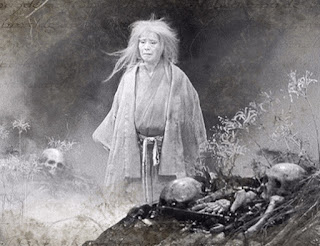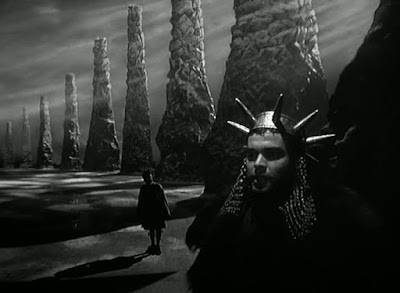My Favorite Films, Plague Edition (Volume 8): The Scottish Films
Macbeth
Written by William Shakespeare
Directed by Orson Welles (1948)
Starring Orson Welles and Jeannette Nolan
Directed by Roman Polanski (1971)
Starring Jon Finch and Francesca Annis
Directed by Rupert Goold (2010)
Starring Patrick Stewart and Kate Fleetwood
Throne of Blood (1957)
Directed by Akira Kurosawa
Starring Toshiro Mifune and Isuzu Yamada
Macbeth is my favorite Shakespearean tragedy, blessed by a vision of hellish darkness, an economical plot without too many sidetrips, and portrayal of complex characters, here the sociopathic couple Macbeth and Lady Macbeth. Viewing several filmed versions this week, some by renowned directors (Kurosawa, Welles, Polanski) brought up some fascinating contrasts. The plot is straightforward. Macbeth driven by a. lust for power, b. his wife, and/or c. sociopathy, murders the King of Scotland, his best friend Banquo, and the wife and children of his rival Macduff. He himself is beheaded by Macduff, invading from England to end Macbeth’s reign of terror in Scotland. And all of this is foretold by the three witches. There is a political point here—Shakespeare was trying to show what a responsible king should be and do—but in modern productions this political message is usually subsumed in the psychological and mystical aspects of the play. Rather that describe each of the four versions I saw (including Throne of Blood) in detail, I will award “best of” prizes.
Best Witches
No contest here. The outright scary witches of the 2016 Goold film mostly pose as creepy nurses in an underground Soviet bunker. Director Rupert Goold brilliantly sets his production as an Eastern Block takeover, with Patrick Steward as a magnificently Stalinesque Macbeth, complete with oversized posters of him decorating the underground bunker that claustrophobically contains the play, amping up the tension and oppressive atmosphere of evil. The rap-style “Boil, boil, toil and trouble” is brilliant, and the temperature of the film drops into subfreezing zone whenever they appear, as they rip out the organs out of maimed patients and create carnage. Second place to the eerie, nearly invisible ghost-witch (below) of Kurosawa, spinning the fate of Macbeth on a loom.
Best Murders
Macbeth gets off to a rousing start as Macbeth and his Lady murder the sleeping King Duncan. Shakespeare and most productions do not actually show the murder itself. Polanski’s film (1971) does. His production is the bloodiest, and shows every stab and slice—is this his psychologic expiation of the murder of his girlfriend Sharon Tate two years earlier by the Manson gang in Los Angeles? Unfortunately, Polanski tends to drag out every scene, highlighting every detail, and emphasizing photographic realism (like panoramas of the castle (Lidesfarne, actually, below) rather than expressionism that better suits this material. Sadly, his two leads are young, pretty, and not very scary, and a drawn-out swordfight at the end diminishes the relentless energy of the play. In contrast, by far the scariest is Goold’s version (2016). Stewart and Fleetwood are vicious killers here (below), drenched in blood and not at all regretful—they just seem like murderers to the core. Ms. Fleetwood projects certain, ruthless sociopathy like no other actor I have seen, and made me think of murderers like Charles Manson and John Wayne Gacy.
Best Burnham Wood
A key, cryptic prediction by the witches is that only when the great Burnham Wood (forest) itself moves and attacks the castle will Macbeth lose the battle. This special effect is always a challenge to pull off on stage, so is generally described, not depicted. Both Welles in 1948 and Kurosawa and 1957 achieve the special effect convincingly. Wells’ set design in general is primeval—all fragments of castles, spooky corridors, fog, rather like a 1930’s Frankenstein movie (below). When the English soldiers camouflage themselves with cut branches to advance on the castle, they seem like advancing plant-creatures, furthering the spooky atmosphere of the film. Kurosawa instead shows them from afar, a writhing distant forest magically expanding towards us, even in the days before computer graphics. In general, Throne of Blood seems like a dry run for the great 1985 Ran, his epic treatment of King Lear, and has wonderful distant panoramas of medieval castles, massed Japanese cavalry, and massed film extras.
Best Sleepwalking Scene
Lady Macbeth’s famed mad scene as she sleepwalks and recoils at
the bloodshed she has unleashed is a famous moment for actresses. Oddly, I was
not blown away by any of these actresses. None quite approaches Judy Dench in
her 1978 TV version —she wipes away the imagined blood on her hands and then unleashes a
blood-curdling 30 second scream that Ingmar Bergman would have been proud of in
Cries and Whispers (see last weeks review). Fleetwood (2016) comes close,
though. I worry that she will awaken and kill us all. Honorable mention to
Francesca Annis (1971), who does it in the nude. Polanski responded to this
controversial decision simply---that’s how they slept in the medieval period,
so a sleepwalker should be nude.
Sir Patrick Stewart is terrific—a sociopathic mix of Stalin,
Ceaucescu, and Charles Manson. The difficult, quick transition in the first 20
minutes from war hero to murderer is not fully explained by Shakespeare—he leaves
us, actors, and directors to fill in the blanks. Stewart makes a convincing
case for Macbeth as a latent sociopath, goaded by both his wife and opportunity
to act on his repressed trait. It is perhaps less tortured and complex than Orson
Welles’ version, but more ruthlessly convincing and coherent. He is equally
good in the ending reflection on the meaningless of individual lives. Welles’
version is tortured, mentally ill, and varied—an old-style virtuoso performance
that is exciting to watch, but ultimately does not clarify the role or
psychology as ably as Stewart. The young Finch (Polanski 1971) and famed
Toshiro Mifune are more one-dimensional and less interesting.
Best Lady Macbeth
This one goes to Fleetwood (2016) in a rout. Watch this Act 1moment when, after hearing that her husband has an opportunity to rule Scotland, immediately
devises the King’s murder, summons evil spirits to help her, and demands to be “unsexed”,
i.e. freed of feminine limits, so she can orchestrate her husband’s bloody
rise to the throne. The lighting, facial angularity, and dramatic delivery
unite into a truly sociopathic horror-show of a portrayal. Honorable mention to
Kurosawa’s Yamada. This director has a talent for making quiet, motionless
Japanese aristocratic women into silent viperlike assassins, communicating evil
intent with minimal vocal inflection.
Best Film
This is surprisingly not close, given the renowned directors in
the game. The claustrophobic, scary 2010 Goold/Stewart/Fleetwood Soviet-era update
is everything a great Macbeth should be. It takes a stand on why Macbeth
turns from a hero into a murderer, presents a fully-formed, frightening Lady
Macbeth, and creates a convincing vision of evil. The terror-state analogy of
Macbeth’s Scotland and Stalin’s Soviet Union are apt. You should see this version
if you want to understand this play. The other films are each limited in their
own ways. I was not quite persuaded by Welles’ mentally-ill take on the title
role, and Polanski’s cute young Macbeth just does not frighten. Mifune plays
his role more as a perturbed Samurai warrior than as a tragic Shakespearean
figure--I think director Kurosawa worked this out better in Ran thirty
years later.
It turns out I am not yet done with the filmed legacy of this great tragedy.
Next week, Lady Macbeth gets to shine on her own….stay tuned.




Comments
Post a Comment